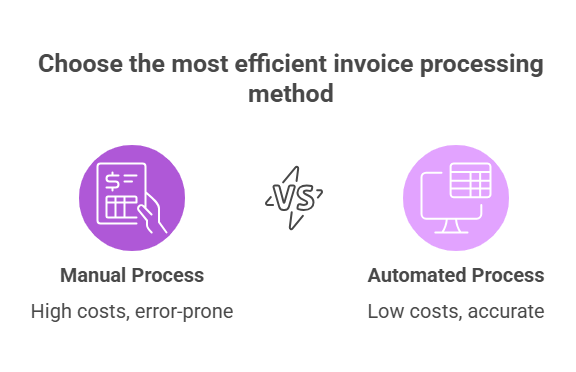
“We’re too small for automation.” That’s what the owner of a 50-employee manufacturing company in Pune told me when I first suggested AP automation. “That’s for big corporations with massive budgets.”
Six months later, he called me back. “We just spent three weeks hunting down a ₹12,50,000 duplicate payment, my AP person is working overtime every month-end, and we nearly lost our biggest supplier because of GST compliance delays. Maybe we need to talk about that automation thing again.”
That conversation perfectly captures why small and mid-sized businesses actually need AP automation more than large enterprises – they can’t afford the mistakes, delays, and inefficiencies that manual processes create.
The Hidden Costs That Add Up Fast
Most SMB owners don’t realize how much their manual AP process is actually costing them. It’s not just the obvious stuff like salaries and stamps. It’s the hidden costs that slowly bleed money from the business.
Let me walk you through the real math. Say you process 200 invoices per month manually. Here’s what that typically costs:
Direct Processing Costs:
- Staff time: 15 minutes per invoice × 200 = 50 hours monthly
- At ₹2,000/hour fully loaded cost = ₹1,00,000 per month
- Supplies, postage, storage = ₹25,000 per month
- Monthly total: ₹1,25,000
Hidden Costs (this is where it gets painful):
- Late payment penalties: ₹40,000-1,65,000 monthly
- Duplicate payments: 2-3% of total payments annually
- Lost early payment discounts: ₹80,000-4,15,000 monthly
- Employee overtime during closing: ₹65,000-1,25,000 monthly
- GST compliance errors and penalties: ₹50,000-2,00,000 monthly
- Hidden costs: ₹2,35,000-9,05,000 monthly
So you’re looking at ₹3,60,000-10,30,000 monthly just to process 200 invoices manually. That’s ₹43,00,000-1,24,00,000 annually for a pretty modest invoice volume.
The SMB ROI Calculation Framework
Here’s a simple framework I use to help SMBs calculate their potential savings:
Step 1: Calculate Current Processing Cost
- Count monthly invoice volume
- Time your actual processing (don’t guess – measure it)
- Include fully loaded labor costs (salary + benefits + overhead)
- Add supplies, postage, storage costs
Step 2: Identify Error Costs
- Track duplicate payments for 3 months
- Calculate late payment penalties
- Estimate lost early payment discounts
- Include time spent on error resolution
Step 3: Factor in Growth Costs
- How much would you need to spend to handle 50% more volume?
- Additional staff costs vs. automation scaling
| Manual Process Costs | Automated Process Costs |
|---|---|
| ₹1,200-2,000 per invoice processed | ₹250-400 per invoice processed |
| Linear scaling (more invoices = more people) | Automatic scaling (same cost for 10x volume) |
| 15-20% error rates | Under 2% error rates |
| 5-7 day processing cycles | Same-day processing |
| Manual GST compliance checking | Automatic GST validation |

The Error Cost Reality Check
I worked with a 75-person company in Bangalore that discovered they were losing ₹6,50,000 monthly to duplicate payments alone. Their manual three-way matching process was missing duplicates because vendors would slightly modify invoice numbers or formatting, and GST validation was happening manually.
After implementing AI-powered AP automation, duplicate payments dropped to virtually zero. That single improvement paid for their automation investment in under four months.
Time Savings That Actually Matter
For SMBs, time savings aren’t just about efficiency – they’re about survival. When your AP person spends 40 hours a month on manual data entry, that’s 40 hours they can’t spend on cash flow analysis, vendor relationship management, or strategic planning.
I watched one company’s AP manager go from working overtime every month-end to having time for vendor negotiations that saved the company ₹40,00,000 annually in better payment terms.
The Growth Multiplier Effect
Here’s something most SMBs don’t consider – what happens when your business grows? Manual processes don’t scale gracefully. You hit volume walls where you suddenly need another full-time AP person, then another, then another.
Automated processes scale smoothly. I’ve seen companies triple their invoice volume without adding AP staff. Instead of hiring costs, they’re investing in growth.
Breaking Even Faster Than You Think
Most SMBs I work with break even on AP automation within 3-6 months. The combination of processing cost savings, error elimination, and early payment discount capture usually pays for the investment quickly.
One 40-employee company calculated they saved their entire annual automation cost in just the first quarter through eliminated duplicate payments and captured early payment discounts.
Making It Affordable for SMBs
The biggest concern I hear from small business owners is upfront cost. “We can’t afford a six-figure automation project.”
That’s where ValueDX has really changed the game for Indian SMBs. Their outcome-based pricing model means you only pay for successful processing – no massive upfront investment, no enterprise-level implementation costs.
For a typical SMB processing 200 invoices monthly, they might pay ₹50,000-80,000 monthly for complete automation including GST compliance. Compare that to the ₹3,60,000-10,30,000 they’re spending on manual processing, and the ROI becomes obvious.
Their AI handles everything – data extraction, GST compliance validation, TDS calculations, fraud detection, approval routing – without the complexity and cost of traditional enterprise systems.
Implementation takes days, not months. Training takes minutes, not weeks. Your team starts seeing benefits immediately.
I’ve watched companies with as few as 20 employees transform their AP operations and start seeing savings within the first month.
Don’t Wait Until It’s Painful
The biggest mistake I see Indian SMBs make is waiting until their manual processes are completely broken before considering automation. By then, they’ve already lost lakhs to errors, delays, and compliance issues.
The math is simple: if you’re processing more than 50 invoices monthly, automation probably pays for itself. If you’re processing more than 100 monthly, automation definitely pays for itself.
Why keep bleeding money on manual processes when you could be investing those savings in growing your business?
Read our next blog – Click here
Author: Gajanan Kulkarni

